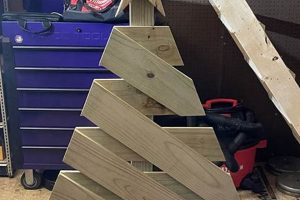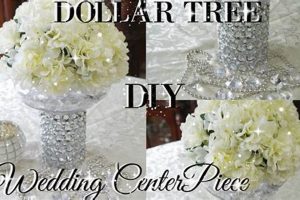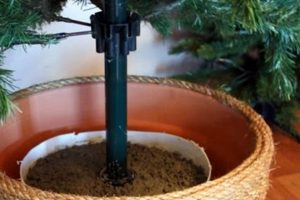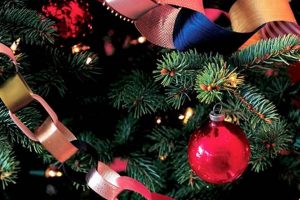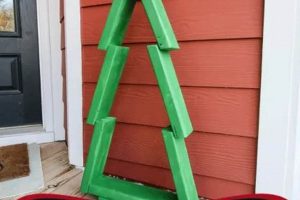The crafting of miniature holiday evergreens using gathered branches and stems represents an increasingly popular seasonal activity. This pursuit involves the selection, preparation, and artistic arrangement of natural materials to create decorative objects mimicking traditional conifers. For example, individuals might collect fallen birch branches or evergreen clippings, then assemble them into a tiered cone shape secured with adhesive or wire.
The significance of this practice lies in its inherent sustainability, cost-effectiveness, and potential for personalization. Utilizing foraged or reclaimed resources minimizes environmental impact while providing a budget-friendly alternative to commercially produced decorations. Historically, resourceful adaptation of available materials has been a common feature of festive celebrations, reflecting cultural values of ingenuity and resourcefulness.
The subsequent sections will address specific methods for construction, offer guidance on selecting appropriate materials, and present design considerations to optimize the aesthetic appeal of these handcrafted holiday decorations.
Essential Guidance for Constructing Miniature Holiday Evergreens from Foraged Branches
The following recommendations aim to assist in the successful fabrication of decorative seasonal objects using collected branches and stems.
Tip 1: Material Selection. Prioritize the use of dry, sturdy branches. Green wood shrinks and may warp during the drying process, potentially compromising the structural integrity of the finished product. Birch, willow, and various evergreen species are suitable candidates.
Tip 2: Branch Preparation. Thoroughly clean collected branches to remove dirt, insects, and loose bark. A wire brush or diluted bleach solution may be employed. Allow branches to dry completely before assembly.
Tip 3: Structural Integrity. A robust base is crucial. Consider using a small, weighted flowerpot or a pre-cut wooden disk to provide stability. Anchor branches securely using wood glue, wire, or a combination thereof.
Tip 4: Cone Formation. When assembling branches to resemble a traditional conifer, maintain consistent angles to achieve a symmetrical and visually appealing form. A template may be beneficial.
Tip 5: Secure Adhesion. Ensure adequate curing time for adhesives. Follow manufacturer’s instructions and avoid stressing the joints before the adhesive has fully set.
Tip 6: Scale and Proportion. Consider the dimensions of the intended display space. Avoid creating an object that is either too large or too small for its surroundings. Maintain proportional balance between the base and the branching structure.
Tip 7: Finish Application. A clear sealant or varnish can protect the finished product from moisture and dust. Consider using a matte finish to maintain a natural aesthetic.
Adhering to these guidelines will enhance the durability and visual quality of these handcrafted seasonal decorations.
The final section will address decorative elements and potential embellishments.
1. Material Sourcing
Material sourcing constitutes a foundational element in the successful creation of decorative miniature evergreens from natural branches. The selection of appropriate materials directly impacts the aesthetic outcome, structural integrity, and overall longevity of the finished piece. Careful consideration must be given to the characteristics of the foraged branches, ensuring they align with the intended design and environmental conditions.
- Wood Species Selection
The species of wood employed exerts a significant influence on the visual character and physical properties of the structure. Hardwoods, such as oak or maple, offer superior strength and durability but may present challenges in workability. Softwoods, including pine or cedar, are easier to manipulate but may be less resistant to moisture and decay. Local availability and aesthetic preference often dictate the choice of wood species.
- Branch Condition and Quality
The condition of the branches is paramount. Dry, seasoned wood is preferred over green wood, as the latter is prone to warping and cracking during the drying process. Branches should be free from signs of rot, insect infestation, or excessive damage. The diameter and straightness of the branches should be considered in relation to the intended scale and design of the miniature evergreen.
- Sustainable Harvesting Practices
Ethical and environmentally responsible material sourcing is crucial. Fallen branches should be prioritized over live cutting to minimize impact on local ecosystems. Awareness of local regulations and restrictions regarding the removal of natural materials is essential. Promoting sustainable harvesting practices ensures the continued availability of resources for future projects.
- Surface Preparation and Treatment
Cleaning and preparation of branch surfaces is an often overlooked, yet crucial, stage that can enhance the structural integrity and overall appearance of the material. Surface preparation includes removing loose bark, dirt, and debris that can inhibit adhesion or promote decay. A mild cleaning solution and a stiff brush are often sufficient for this task. In certain cases, a light sanding may be necessary to smooth rough edges or create a more uniform surface for adhesion.
The interrelationship between these material sourcing factors determines the ultimate success of any miniature evergreen creation. By carefully considering wood species, branch condition, sustainable practices, and surface preparation, creators can ensure their projects are not only visually appealing but also durable and environmentally responsible, resulting in a lasting and rewarding decorative object.
2. Structural Design
The arrangement of branches and the underlying framework define the structural design of miniature holiday evergreens crafted from natural elements. This design significantly impacts the objects stability, visual appeal, and long-term durability. A well-considered structure ensures the creation can withstand handling and display without collapsing or losing its intended form.
- Base Stability and Weight Distribution
The foundation of the structure is paramount. A wide, stable base is necessary to support the weight of the branches and any applied decorations. Weight distribution must be carefully considered to prevent the creation from becoming top-heavy and prone to tipping. A heavier base material, such as wood or stone, may be incorporated to improve stability. For example, attaching branches to a pre-cut wooden circle offers a solid foundation, distributing weight evenly across the base.
- Branch Angle and Tiering
The angle at which branches are attached and the manner in which they are tiered contribute significantly to the overall form. Branches angled upwards create a more traditional conical shape, while horizontal or downward-sloping branches offer a more stylized or contemporary appearance. Consistent tiering helps maintain symmetry and visual balance. An example is a progressively smaller branches for each ascending tier to achieve a realistic form.
- Central Support System
For taller or more elaborate designs, a central support system may be necessary. This can take the form of a dowel rod, a length of wire, or a tightly bound bundle of twigs extending vertically through the center of the structure. The central support provides added stability and prevents the branches from splaying outwards over time. In cases of heavy branches or elaborate structures, the incorporation of a sturdy internal support can prevent collapse under its own weight.
- Joint Integrity and Reinforcement
The points where branches are joined to the base or central support must be strong and secure. Adhesive alone may not be sufficient, particularly for heavier branches. Reinforcement techniques, such as wrapping joints with wire or twine, can significantly improve structural integrity. Example includes the combination of wood glue and wire, for instance, create a more robust joint, capable of withstanding stress and movement.
Effective structural design, achieved through careful consideration of base stability, branch arrangement, internal support, and joint integrity, is essential for producing a durable and visually pleasing miniature holiday evergreen from natural branches. These structural elements determine not only the aesthetic outcome but also the lasting quality of this handcrafted item.
3. Assembly Techniques
The fabrication of decorative miniature holiday trees from foraged branches hinges on the application of appropriate assembly techniques. The chosen method dictates not only the structural integrity of the finished piece but also its aesthetic qualities and overall longevity. Selection of the correct assembly method is therefore paramount to the project’s success.
- Adhesive Bonding
Adhesive bonding involves the use of substances to join branches to a central support or base. Options include wood glue, hot glue, and epoxy resins. Wood glue provides a strong, permanent bond but requires clamping and extended drying time. Hot glue offers rapid bonding but may lack long-term durability and can be susceptible to temperature changes. Epoxy resins provide exceptional strength and water resistance but require careful mixing and can be more costly. The selection of adhesive should be based on the materials being joined, the desired strength of the bond, and the environmental conditions to which the finished piece will be exposed. An example is using wood glue for a sturdy base and hot glue for delicate ornaments.
- Wire Wrapping
Wire wrapping utilizes thin-gauge wire to physically secure branches to a support structure or to one another. This technique offers both structural reinforcement and a rustic aesthetic. Wire can be concealed or intentionally exposed to create different visual effects. Copper, steel, or floral wire can be employed, with the choice dependent on the desired strength and visual appeal. This method enhances joint strength and provides a durable structure. For instance, wrapping wire around branches attached to a central dowel rod enhances stability.
- Drilling and Fastening
For larger branches or more substantial structures, drilling and fastening with screws or nails may be appropriate. This method provides a highly secure and permanent connection but requires the use of power tools and careful alignment to prevent splitting the wood. Pilot holes should be drilled prior to inserting screws or nails to minimize the risk of damage. This ensures solid, mechanical joins. For example, screws are used to attach branches to a thick wooden base.
- Interlocking and Weaving
This technique utilizes the natural flexibility of some branch types to create interlocking structures. Willow, birch, and other pliable branches can be woven together to form a self-supporting framework. This method relies on the inherent strength of the materials and requires careful planning and execution. This provides an appealing natural aesthetic. For instance, weaving thin willow branches around a central frame can create a unique and stable structure.
The successful creation of miniature holiday evergreens from natural branches necessitates a thorough understanding of available assembly techniques. The choice of method should be guided by the materials used, the desired aesthetic, and the intended longevity of the finished piece. Combining different techniques can further enhance the structural integrity and visual appeal of these handcrafted seasonal decorations. For instance, one can combine wire wrapping with adhesive bonding for enhanced strength.
4. Adhesive Selection
Adhesive selection is a critical consideration in the creation of miniature holiday evergreens constructed from foraged branches. The chosen adhesive directly influences the structural integrity, durability, and overall aesthetic of the finished piece.
- Bond Strength and Material Compatibility
The adhesive must possess adequate bond strength to securely join the selected branch materials. Different wood species and branch textures may necessitate different adhesive formulations. A mismatch between adhesive and material can result in weak bonds and structural failure. Examples of commonly used adhesives include wood glue, hot melt adhesive, and cyanoacrylate adhesives (super glue), each possessing distinct properties suited to specific applications.
- Drying Time and Working Time
The adhesive’s drying and working times significantly impact the assembly process. Rapid-setting adhesives, such as hot melt adhesive or cyanoacrylate adhesives, allow for quicker assembly but may limit repositioning time. Slower-setting adhesives, such as wood glue, provide ample working time but require clamping or support during the curing process. The choice depends on the complexity of the design and the assembler’s level of experience.
- Environmental Resistance
The finished miniature evergreen may be exposed to varying environmental conditions, including temperature fluctuations and humidity. The selected adhesive should exhibit resistance to these factors to prevent bond degradation. Water-resistant adhesives, such as polyurethane-based glues, are preferred for projects intended for outdoor display or areas prone to moisture. For indoor projects a less resistant adhesive may be appropriate.
- Aesthetic Considerations
The adhesive’s appearance can impact the overall aesthetic of the piece. Excessive adhesive squeeze-out or visible glue lines detract from the natural beauty of the branches. Choosing an adhesive that dries clear or can be easily concealed minimizes visual imperfections. For example, judicious application of wood glue along branch joints, followed by careful wiping of excess, prevents unsightly residue. Also consider that some adhesives may be paintable, which allows for cosmetic adjustments if necessary.
Therefore, informed adhesive selection, predicated on considerations of bond strength, drying time, environmental resistance, and aesthetic impact, is integral to producing durable and visually appealing miniature holiday evergreens constructed from natural branches. Careful adhesive consideration contributes significantly to the success of “diy christmas tree twigs”.
5. Aesthetic Refinement
Aesthetic refinement constitutes a critical phase in the creation of decorative miniature holiday evergreens from foraged branches, directly influencing their visual appeal and perceived value. The success of “diy christmas tree twigs” is intrinsically linked to the attention given to detailing, proportionality, and the overall harmony of the design. Poor aesthetic choices can undermine the structural integrity and material quality of the creation, resulting in a product that fails to resonate visually. For example, an evergreen might be structurally sound and made from high-quality branches, but haphazard twig placement or an unbalanced silhouette can diminish its aesthetic value.
Effective aesthetic refinement encompasses several key aspects. Symmetry and balance are paramount; consistent branch angles and even distribution of foliage contribute to a visually pleasing form. Color harmony, achieved through careful selection of branch types and the strategic addition of embellishments, can enhance the overall appeal. Texture plays a crucial role, with contrasting branch textures creating visual interest. Consider, for example, the use of smooth birch branches alongside rough pine needles to create tactile and visual depth. The addition of decorative elements, such as miniature ornaments, ribbons, or artificial snow, must be carefully considered to avoid overwhelming the natural beauty of the underlying materials.
In conclusion, aesthetic refinement is not merely a superficial addition but an integral component of the crafting process. The thoughtful application of design principles, meticulous attention to detail, and a sensitivity to material properties are essential for transforming foraged branches into visually captivating miniature holiday evergreens. Successfully navigating the challenges of aesthetic refinement is crucial for elevating “diy christmas tree twigs” from simple craft projects to cherished decorative objects.
6. Long-term Preservation
The longevity of decorative miniature evergreens crafted from natural branches hinges upon implementing effective preservation strategies. Without appropriate measures, these handcrafted items are susceptible to degradation, diminishing their aesthetic value and structural integrity over time.
- Moisture Control
Excessive moisture promotes mold growth, wood rot, and insect infestation, all of which can compromise the integrity of branches. Storing these pieces in dry environments is essential. Desiccants, such as silica gel packets, may be employed to absorb ambient humidity. Furthermore, avoid displaying these items in areas prone to condensation or water exposure. An example includes storing the evergreens in a climate-controlled storage area during the off-season, away from damp basements or humid attics.
- Pest Management
Natural branches can harbor insect larvae or eggs, which may hatch and damage the structure. Prior to assembly, thorough cleaning and, if feasible, heat treatment (e.g., baking at a low temperature) can eliminate potential pests. Regular inspection for signs of infestation, such as frass (insect droppings) or visible insects, is recommended. Insecticides or protective coatings may be applied, but caution should be exercised to ensure compatibility with the materials and safety for handling. For instance, using a borate solution to treat the wood can deter insects.
- UV Protection
Exposure to ultraviolet (UV) radiation from sunlight can cause fading, discoloration, and embrittlement of branches, particularly those with natural dyes or finishes. Displaying these pieces away from direct sunlight or applying a UV-resistant coating can mitigate these effects. Using branches naturally resistant to UV degradation also prolongs life. An example is applying a clear coat with UV inhibitors to protect color.
- Structural Reinforcement and Repair
Over time, joints may weaken, and branches may become brittle. Periodic inspection and reinforcement of weak points can extend the lifespan of the structure. Loose branches can be re-glued or re-wired. Cracks or splits can be repaired with wood filler or epoxy. Proactive maintenance prevents minor damage from escalating into major structural failures. For instance, reapplying glue to any weakened joints extends the life of the structure.
These strategies, when implemented diligently, contribute significantly to the long-term preservation of decorative miniature evergreens created from natural branches. These “diy christmas tree twigs” can become treasured decorations passed down from generation to generation with proper care and protection. Adhering to these measures ensures the continued aesthetic enjoyment of these handcrafted items, showcasing the artistry and labor invested in their creation.
Frequently Asked Questions Regarding Miniature Holiday Evergreens Constructed from Natural Branches
This section addresses common inquiries concerning the creation, maintenance, and longevity of miniature holiday evergreens crafted from foraged branches. The information presented aims to provide clear, concise guidance based on best practices.
Question 1: What branch types are most suitable for constructing durable miniature evergreens?
Durable miniature evergreens typically benefit from the utilization of seasoned hardwoods, such as oak or maple, for their structural framework. Softer woods, like pine or fir, are well-suited for foliage representation. Thorough drying of branches prior to assembly is crucial for preventing warping and cracking.
Question 2: How can insect infestation within foraged branches be prevented?
Prior to assembly, branches should undergo a thorough cleaning process to remove dirt, debris, and any visible insects or eggs. Heat treatment, involving baking the branches at a low temperature (approximately 200F or 93C) for a period of one to two hours, can effectively eliminate potential infestations.
Question 3: Which adhesive types offer the strongest and most durable bond for branch assembly?
Epoxy resins and polyurethane-based glues generally provide the most robust and water-resistant bonds for joining branches. Wood glue is also a viable option for interior applications, provided adequate clamping and drying time are employed. Hot melt adhesive is generally unsuitable for long-term durability.
Question 4: How can the aesthetic appeal of miniature evergreens be enhanced without compromising their natural appearance?
Subtle enhancements, such as the strategic application of clear varnish or sealant, can protect the branches while preserving their natural texture and color. Minimalist ornamentation, employing small, lightweight objects like miniature pinecones or beads, can add visual interest without overwhelming the design.
Question 5: What are the optimal storage conditions for preserving miniature evergreens during the off-season?
These items should be stored in a cool, dry location away from direct sunlight. Wrapping the evergreen in acid-free tissue paper or placing it within a breathable storage container can further protect it from dust, moisture, and insect damage. Avoid airtight containers, which can trap moisture and promote mold growth.
Question 6: How can structural damage to miniature evergreens be repaired effectively?
Minor damage, such as loose branches or cracks, can often be repaired with wood glue or epoxy resin. Reinforcing weak joints with wire or twine can provide added stability. Major structural failures may necessitate complete disassembly and reconstruction, utilizing replacement branches as needed.
The successful creation and preservation of these decorative objects require a commitment to meticulous material selection, proper assembly techniques, and diligent maintenance practices. Adherence to these principles ensures the enduring beauty of these handcrafted seasonal decorations.
The following section provides concluding remarks and potential avenues for further exploration.
Conclusion
The preceding sections have thoroughly explored the multifaceted aspects of crafting miniature seasonal decorations from natural branches. The successful execution of “diy christmas tree twigs” projects requires careful consideration of material sourcing, structural design, assembly techniques, adhesive selection, aesthetic refinement, and long-term preservation strategies. Adherence to these guidelines ensures the creation of durable and visually appealing objects.
The value of this pursuit extends beyond the mere creation of decorative items. It encompasses resourcefulness, environmental consciousness, and the opportunity to cultivate artistic expression. Future endeavors might focus on exploring innovative techniques, sustainable sourcing practices, or incorporating technology to enhance the design and construction process. The enduring appeal of “diy christmas tree twigs” lies in its capacity to blend tradition with individual creativity, resulting in unique and cherished keepsakes.


